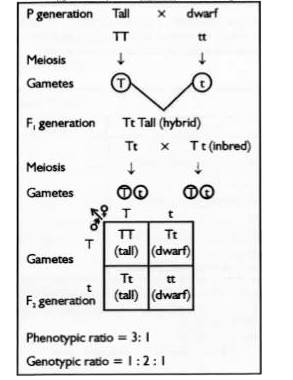How do Mendel's experiments show that traits may be dominant or recessive? explain it with the help of a cross.Solution in Kannada
When two pure bred parents with different traits for a character is crossed, they always give rise to a Fl hybrid in which phenotypically the dominant trait is expressed. . When this hybrid is self fertilised, 75% of the F2 generation will have a trait which is dominant and a mere 25% will have the recessive trait.
Eg: Crossing of Homozygous tall plants with short plants give heterozygous tall plants (hybrid) in the Fl generation.

This shows that tallness is a dominant trait in pea plants. When these hybrid plants are self fertilised, they give rise to tall and short plants in the phenotypic ratio of 3:1. So trait for shortness is considered recessive.
Topper's Solved these Questions
- BOOK - ZEN PUBLICATIONCHAPTER - HEREDITY AND EVOLUTION EXERCISE - QUESTIONS SECTION (TEXTUAL QUESTIONS)24videos
HEREDITY AND EVOLUTION
- BOOK - ZEN PUBLICATIONCHAPTER - HEREDITY AND EVOLUTION EXERCISE - ZEN ADDITIONAL QUESTIONS SECTION (MULTIPLE CHOICE QUESTIONS)42videos
HEREDITY AND EVOLUTION
- BOOK - ZEN PUBLICATIONCHAPTER - CONTROL AND COORDINATIONEXERCISE - ZEN ADDITIONAL QUESTIONS SECTION (HOTS [HIGHER ORDER THINKING SKILLS] - QUESTIONS)2videos
CONTROL AND COORDINATION
- BOOK - ZEN PUBLICATIONCHAPTER - HOW DO ORGANISMS REPRODUCE?EXERCISE - ZEN ADDITIONAL QUESTIONS SECTION (SHORT ANSWER [SA] TYPE 2 QUESTIONS)36videos
HOW DO ORGANISMS REPRODUCE?
Similar Questions
A Mendelian experiment consisted of breeding tall pea plants bearing violet flowers with short pea plants bearing white flowers. The progeny all bore violet flowers, but almost half of them were short. This suggests that the genetic make up of the tall parent can be depicted as
03:28View SolutionThe following vegetables are kept in a basket: Potato, Tomato, Radish, Brinjal, Carrot, Bottle-gourd which two of these vegetables correctly reresent the homologous structure?
03:42View SolutionThe organ A which is located inside the skull of our body is protected by a bony box B and it is surrounded by 3 membranes C. The space between the membranes is filled with liquid D which protects the organ A from mechanical shock. The organ A in combination with another organ E makes up the central nervous system.
i] What is organ A?
ii] What are B, C and D?
iii] Name the organ E.
iv] If we step out from a dark room into bright sunlight, we close our eyes for a moment. Which of the two organs A or E is directly involved in this sunshine?02:58View SolutionExplain fission with examples. Differentiate between binary and multiple fission. Draw a well labelled diagram of binary fission in amoeba.
View SolutionHow do Mendel’s experiments show that traits may be dominant or recessive?
View Solution(a) How do Mendel's experiments show that traits may be dominant or recessive ?
(b) How do Mendel's experiments show that traits are inherited independently ?View SolutionHow do Mendel's experiments show that traits may be dominant or recessive?
05:41View SolutionHow do Mendel's experiments show that traits may be dominant or recessive?
03:32View SolutionHow do Mendel's experiments show that the (a) traits may be dominant or recessive, (b) traits are inherited independently?
03:55View SolutionHow do Mendel's experiments show that traits may be dominant or recessive ?
02:58View SolutionHow do Mendel’s experiments show that traits may be dominant or recessive?
02:30View SolutionHow do Mendel's experiments show that
a] traits may be dominant or recessive?
b] inheritance of two traits is independent of each other?05:36View SolutionHow do Mendel's experiments show that traits may be dominant or recessive? explain it with the help of a cross.
03:14View SolutionHow do Mendel's experiments show that traits may be dominant or recessive?
03:56View SolutionHow does Mendel's experiment show that traits may be dominant or recessive?
View Solution(a) How do Mendel's experiments show that traits may be dominant or recessive ? (b) How do Mendel's experiments show that traits are inherited independently ?
View Solution

